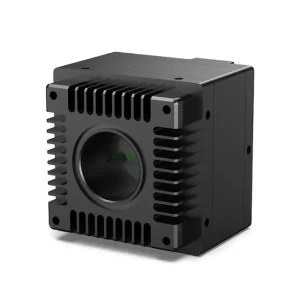Near-infrared (NIR) imaging covers the portion of the spectrum just beyond human vision (roughly 0.7–1.4 µm, though by some definitions extending to ~2.5 µm). NIR cameras use semiconductor sensors (silicon CCD/CMOS or InGaAs) to detect these longer wavelengths. In practice, many “visible” cameras become NIR-capable simply by removing the normal IR‑cut filter. NIR cameras are typically monochrome (no Bayer filter), since color filters block IR. Operation is otherwise similar to visible imaging: incoming NIR photons generate charge in a pixel array, which is then clocked out to form an image. Because ambient light in the NIR is weak at night, NIR systems often use active illumination (e.g. infrared LED arrays around 850–940 nm) so scenes can be lit invisibly.
Digital cameras have intrinsic NIR sensitivity (silicon detects up to ~1100 nm), but standard models include a blocking filter to mimic human vision. When that filter is removed (or in cameras built without it), the sensor records both visible and NIR light. Spectral response: Silicon devices are efficient in visible light and into the NIR – deep‑depletion CCDs can approach 60–70% quantum efficiency at 800–900 nm – but sensitivity falls off above ~1000–1100 nm. For imaging well beyond 1100 nm, III–V sensors like InGaAs are used. InGaAs focal‑plane arrays (FPAs) consist of an InP substrate with an InGaAs absorption layer bump-bonded to readout electronics. These detectors are typically sensitive from ~900 to 1700 nm, with some variants extending to ~2.2 µm or beyond by compositional changes (e.g. mercury–cadmium–telluride in astronomy’s NIRCam covers 0.6–5 µm). InGaAs sensors can achieve very high quantum efficiency (>85% from 900–1500 nm), but at the cost of much higher dark current and read noise than silicon. For example, uncooled InGaAs arrays may exhibit ~10²–10⁴ electrons/pixel/sec of dark current (vs <0.001 e⁻/px/s for cooled silicon CCD), so NIR cameras are often cooled (thermoelectric or cryogenic) to suppress this noise.
NIR vs. Visible and Thermal Imaging
Visible vs. NIR: The key distinction is simply wavelength and illumination. A standard camera “sees” the visible spectrum (400–700 nm) by design; by removing its IR-blocking filter (or using a built-in “NoIR” sensor), the same device can also capture NIR. In daylight, NIR images look like high-contrast, monochrome views of the scene – for example, foliage appears bright because chlorophyll reflects NIR strongly. Human eyes cannot see this light, so NIR illumination (often from IR LEDs) is invisible but still recorded by the camera. NIR imaging is thus often used in very low-light or “night vision” scenarios by flooding the scene with 850 nm LEDs. (For example, many security cameras mount an IR-LED ring around the lens so they can “see” at night.)
Thermal (Mid/Far-IR) vs. NIR: Thermal cameras image much longer infrared wavelengths (typically 3–14 µm) to measure emitted heat. Thermals use microbolometer or photon detectors and produce temperature-mapped images. Unlike NIR, thermal cameras operate passively – they do not need any external light source, since all objects emit some IR radiation based on temperature. As a result, thermal imagers can “see” in complete darkness and through some obscurants (smoke, haze). NIR cameras, by contrast, rely on reflected or artificially illuminated NIR light and require at least some photons. In practice, this means NIR (night-vision) cameras need a light source (visible or IR LED) to form an image, whereas thermal cameras do not.
Key differences in imaging modes:
- Illumination: NIR/night-vision cameras need ambient or LED light (often near 850 nm); thermal cameras need none.
- Wavelength band: NIR sees ~0.7–1.1 µm (silicon) or up to ~1.7 µm (InGaAs); thermal sees ~3–14 µm.
- Image content: NIR yields high-resolution detail similar to a visible photo (objects look like they do in moonlight), while thermal images show temperature contrasts, often colorized.
- Technology: NIR uses silicon or InGaAs photodiodes (photovoltaic sensors). Thermal uses microbolometers or cooled photon detectors (e.g. HgCdTe) sensitive to mid/far IR.
In summary, NIR cameras are essentially sensitive photographic cameras extended into the infrared, whereas thermal cameras are fundamentally different instruments that produce thermograms without lighting.
Wavelength Ranges and Detector Types
NIR imaging generally covers two overlapping bands. The common NIR/VNIR band is ≈0.7–1.1 µm (visible–NIR), which silicon detectors (CCD/CMOS) can capture. Short-wave infrared (SWIR) usually refers to ≈0.9–1.7 µm (some sources say up to 2.5 µm). Silicon sensors fade out by ~1.1 µm (silicon’s bandgap), so beyond that one uses indium‑gallium‑arsenide (InGaAs) or related materials. Detector types:
- Silicon CCD/CMOS: Standard image sensors (CCD or CMOS) with no IR filter will detect from ~400 nm up to ~1000–1100 nm. Some industrial cameras use “deep-depletion” or thick‑substrate silicon to boost NIR QE; for example, Basler’s NIR‑optimized Ace cameras use CMOS sensors (ams CMV2000/4000) with thicker silicon to roughly double sensitivity at 850 nm. Typical sensors cover 400–1000 nm, with QE often 30–60% peak.
- InGaAs FPA: For 900–1700 nm imaging, InGaAs photodiode arrays are used. An InGaAs FPA has an InP substrate and InGaAs absorbing layer bump‑bonded to a readout IC. These detectors excel in the NIR/SWIR: e.g. Teledyne Princeton’s NIRvana cameras use a 640×512 InGaAs array. Typical InGaAs covers 900–1700 nm with QE often >80% over much of that range. InGaAs cameras usually have larger pixels (10–20 µm) and are often cooled (down to –50°C or colder) to reduce dark current.
- Extended SWIR/TWIR: Modified InGaAs or HgCdTe detectors can extend sensitivity toward 2–3 µm and beyond (up to ~2.2 µm in the lab, or ~5 µm for mercury-cadmium-telluride as in JWST’s NIRCam). These are specialized (often called MWIR or thermal depending on range).
- Other cameras: Some low-cost night-vision systems use image intensifiers (photomultiplier tubes) with NIR sensitivity, but these are analog/night-vision tubes, not typical in standard NIR camera markets.
In practice, most commercial NIR cameras use either silicon-based global-shutter sensors for 0.8–1.0 µm (with IR filter removed) or InGaAs sensors for 0.9–1.7 µm. (For completeness, mid-wave IR (~3–5 µm) uses InSb or HgCdTe, and far-IR (~8–14 µm) uses microbolometer arrays – but those are classified as thermal imagers rather than NIR.)
Key Performance Metrics
NIR cameras are evaluated on the usual imaging metrics, with special emphasis on IR-related factors. Key parameters include:
- Spectral sensitivity (range/QE): The useful wavelength band and quantum efficiency (QE) vs. wavelength. Silicon sensors might offer ~50–70% QE in the visible and 800–900 nm, dropping toward zero by ~1100 nm. InGaAs sensors can sustain >85% QE from 900–1500 nm. Manufacturers often publish spectral response curves. A useful metric is the cutoff wavelength (e.g. “InGaAs 1.7 µm cutoff”, meaning sensitive up to ~1.7 µm).
- Resolution: Pixel count and array size. Typical NIR cameras range from VGA (0.3 MP) up to a few megapixels. InGaAs cameras tend to have smaller arrays (e.g. 640×512 or 1024×1024) than visible CMOS/CCD cameras, due to cost and yield issues. Pixel size is often larger (5–20 µm). Larger pixels collect more light (higher sensitivity) but reduce spatial resolution for a given sensor area. For example, Princeton’s NIRvana InGaAs cameras use 20 µm pixels, which gives 4× the light-collection of a 10 µm pixel.
- Frame rate: How many frames per second at full resolution (or with ROI). This depends on sensor and interface (USB3, GigE, CoaXPress, etc.). High-end SWIR cameras can be quite fast: e.g. Andor’s C-RED2 (InGaAs) can do up to 600 fps full-frame. Many NIR webcams or machine-vision cameras might be 30–120 fps at moderate resolutions. (Note: high frame rates usually mean lower resolution or shorter bit depths.)
- Noise: Includes read noise and dark current noise. Silicon cameras (especially cooled CCDs) can achieve very low dark current (<0.0001 e⁻/px/s), while InGaAs devices typically have much higher dark current (often 10–10^4 e⁻/px/s depending on temperature). Read noise (electronic noise per frame) might be a few electrons for scientific cameras. Manufacturers often specify “dark current @ 0°C” and “read noise” (e⁻) in datasheets. Cooling (Peltier or liquid nitrogen) is used in scientific NIR cameras to reduce dark noise and allow longer exposures.
- Dynamic range and SNR: NIR cameras may have wide dynamic range (e.g. 12–16 bits) similar to visible sensors. The overall sensitivity is often given as the minimum detectable irradiance or the equivalent detectivity. Ultimately, the signal-to-noise ratio (SNR) under given illumination is a key figure of merit. Princeton’s analysis shows that deep-cooled InGaAs cameras (like their NIRvana LN) achieve superior SNR by combining high QE and low noise.
- Shutter type: Machine-vision NIR cameras often use global shutters (to freeze motion), while many low-cost ones might use rolling shutters.
- Other metrics: For some applications one considers IR-specific factors like solarization (damage under bright IR light), full-well capacity (photons before saturation), and blooming/crosstalk which can differ for IR. (See sensor datasheets for details.)
In summary, the important NIR metrics mirror those of any camera (resolution, speed, noise) but with the addition of spectral response and dark current as critical IR-specific factors.
Major Application Areas
NIR cameras see use across many fields. Some notable applications include:
- Surveillance and Security: NIR CCTV and security cameras enable clear night-time vision. These systems flood scenes with invisible IR light (usually 850 nm LEDs) so that a monochrome NIR-sensitive camera can see in the dark. Applications include perimeter security, traffic monitoring, and covert observation. Biometric systems (iris and face recognition) often use NIR illumination because it highlights eyes and skin features while remaining invisible to users.
- Industrial Inspection and Machine Vision: Many manufacturing and inspection tasks use NIR illumination to reveal defects or features not seen in visible light. Examples: detecting cracks or moisture in materials, inspecting solar wafer electroluminescence (where silicon emits NIR light), sorting produce (damaged fruit often has different NIR reflectance), and gluing/assembly inspection under NIR light. NIR is also used for monitoring printed electronics (where NIR passes through ink). In general, NIR cameras allow high-contrast imaging of objects with particular spectral characteristics, simplifying automated inspection in low-light or difficult conditions.
- Agriculture and Remote Sensing: Plant health and vegetation monitoring heavily rely on NIR imaging. Healthy green plants absorb visible red light but strongly reflect NIR (around 700–1300 nm). Aerial or satellite NIR cameras (or multispectral cameras with an NIR band) compute indices like NDVI = (NIR – red)/(NIR + red) to quantify vegetation vigor. Precision agriculture uses drones with NIR cameras to map crop stress, soil moisture, and nutrient levels. In food processing, NIR imaging can sort or grade crops (e.g. identifying blemishes that are transparent to visible but visible in NIR).
- Medical and Life Sciences: NIR imaging penetrates deeper into biological tissue than visible light. NIR fluorescence imaging (using dyes like indocyanine green at ~800 nm) is used in image-guided surgery and vascular imaging. Near-IR transillumination can reveal veins (vein-finder devices). Some microscopes and in-vivo systems use InGaAs cameras for deep tissue imaging or optogenetics. For example, Andor’s C-RED SWIR cameras are marketed for neuroscience and developmental biology to image through thick samples. While standard clinical imaging is mostly in visible light, NIR offers non-destructive diagnostics (e.g. differentiating healthy and cancerous tissue via NIR absorption) and is an active research area.
- Astronomy: Many telescopes carry NIR cameras. Infrared astronomy probes cooler objects or objects obscured by dust. For instance, the James Webb Space Telescope has a NIRCam instrument (0.6–5 µm) with HgCdTe detectors. Ground-based observatories also use InGaAs or HgCdTe NIR cameras for stellar and planetary imaging. Although these detectors are beyond the usual “machine vision” cameras, it underscores the NIR regime’s importance in science.
- Other areas: NIR cameras serve in art conservation (revealing underdrawings in paintings), manufacturing (hot-spot detection with IR-emitting materials), law enforcement (surveillance), and consumer electronics (some smartphones use IR cameras for face unlock/ToF sensing, though those often are 3D sensors rather than image cameras).
In short, surveillance, industrial quality control, precision agriculture, medical imaging, and astronomy are major domains for NIR cameras. In each case, the ability to image beyond human vision – often in darkness or through obscurants – is exploited for enhanced information.
Leading Manufacturers and Common Models
Many specialized manufacturers produce NIR cameras or sensors. Notable examples include:
1. Lontenoe: Lontenoe’s Visible Light⁺ Near-Infrared Camera:
Dual-Spectrum Imaging: Capable of capturing images in both the visible and NIR ranges, allowing for comprehensive analysis in various lighting conditions.
High Sensitivity: Utilizes advanced sensor technology to detect subtle differences in light intensity, enhancing image quality in low-light environments.
Compact Design: Engineered for integration into systems where space is at a premium, without compromising performance.
Versatile Applications: Ideal for use in surveillance, industrial inspection, scientific research, and other fields requiring detailed imaging across multiple spectra.
2. Basler (Germany): A major machine-vision camera vendor. Basler’s Ace2 NIR cameras use Sony/ams sensors with enhanced NIR response. These models (2–4 MP) achieve ~40% QE at 850 nm, roughly double a normal camera at that wavelength. Basler also offers SWIR cameras (Basler Ace 2 SWIR) based on InGaAs. (Basler was acquired by Cognex in 2022.)
3. Hamamatsu Photonics (Japan): Offers InGaAs-based SWIR camera modules. Their InGaAs cameras span 950–1700 nm, bridging the gap where silicon fails. Hamamatsu’s products are often used in lab and OEM systems for NIR/SWIR imaging.
4.Teledyne Technologies (USA): Through subsidiaries (Allied Vision, Princeton Instruments, Sensors Unlimited, FLIR), Teledyne sells a range of NIR/SWIR cameras. Examples: Allied Vision’s Goldeye SWIR series (InGaAs), Teledyne Princeton’s NIRvana scientific InGaAs cameras, and Sensors Unlimited’s portable SWIR video cameras. These include cooled scientific models and ruggedized modules.
5.Xenics (Belgium): Specializes in infrared detectors and cameras. Xenics provides InGaAs SWIR cameras (e.g. Bobcat, Owl series) and more (uncooled microbolometer etc.). They have broad NIR/SWIR product lines.
6.Andor (Oxford Instruments): Offers high-end research cameras (e.g. C-RED2). C-RED2 is an InGaAs camera with extremely low noise (read noise <30 e⁻, dark <600 e⁻/s) and very high speed (up to 600 fps). These serve neuroscience, microscopy, and astronomy (the C-RED 2 ER variant extends to 2.2 µm).
7.IDS Imaging, JAI, Optronis, Allied Vision: Many machine vision camera brands provide NIR-capable models (often monochrome sensors with IR-filter off or custom). For example, IDS has the UI-5280LE-C NIR camera, JAI sells NIR‐sensitive cameras, and Optronis offers compact SWIR cameras. (Allied Vision’s former Goldeye line is now under Teledyne.)
8.New Imaging Technologies (NIT), Raptor Photonics, Lumenera: Other specialized vendors with SWIR cameras (often analog or digital InGaAs modules) for security, defense, and research.
Common models reflect these vendors: for instance, Basler’s ace 2 SWIR, Hamamatsu’s InGaAs C10940 series, Teledyne’s Goldeye G-130, and Andor’s C-RED 2. On the low end, there are USB/CSI cameras (Raspberry Pi NoIR, Arducam etc.) with IR filters removed, which serve DIY and embedded projects.
Integration and System Considerations
Building a complete NIR imaging system involves several practical points:
- Optics and Lenses: Not all lenses transmit NIR equally. Glass lens materials and coatings should be chosen for high transmission at the target NIR band. Some lenses are AR-coated for 700–1000 nm or SWIR ranges. Also, focus shifts can occur in NIR (different refractive index), so focusing at NIR wavelengths (or using motorized focus) is important. C-mount and F-mount lenses are common; ensure they are rated for near-IR.
- IR Filters and Filters: Many systems use interchangeable filters. To isolate NIR, one can use a long-pass or band-pass filter (e.g. 850 nm LPF) in front of the camera, blocking visible light. Alternatively, one may remove the camera’s IR-block filter (as noted) to pass full NIR and visible. For dual-band cameras, motorized filter wheels or sliding filters allow switching between modes. Proper filtering can greatly improve contrast (e.g. blocking unwanted ambient wavelengths).
- Illumination: Active IR illumination is common. Arrays of IR LEDs (typically 850 nm or 940 nm) or laser diodes provide light invisible to humans. 850 nm is common for sensitivity, while 940 nm is less visible even to animals. Imatest notes that standard silicon sensors respond well to IR up to 1100 nm, so an 850 nm LED source (filtered or narrowband) is popular. For SWIR (1000–1700 nm) you need InGaAs LEDs or lamps (e.g. tungsten-halogen) that emit in that range. Careful placement of LEDs and use of diffusers ensures uniform lighting.
- Sensor Interface and Control: NIR cameras come in the same form factors as visible cameras (USB3, GigE, CoaXPress, Camera Link, etc.). Choosing a high-bandwidth interface may be necessary for high frame rates or large data volumes. Shutter and gain controls work as usual. Some NIR cameras (especially cooled scientific ones) require additional power or control for Peltier cooling.
- Image Processing and Software: NIR images are often monochrome. Software may apply false-color palettes for display, or compute indices (e.g. NDVI in agriculture requires combining NIR and visible images). Calibration is important: flat-field correction (to remove vignette and sensor non-uniformity) and bad-pixel maps may be needed, especially for InGaAs arrays. Many systems use standard machine-vision or scientific software; specialized algorithms may include background subtraction of ambient NIR. If combining visible and NIR, one must handle white balance and spectral calibration carefully.
- Mechanical Integration: Housing should prevent stray light and protect from dust/IR from warm surfaces. Many NIR camera modules exist (C-mount, board-level, rugged enclosures). Thermal management is key if cooling is used. Safety: if using NIR lasers, one must consider eye-safety regulations (though 850–940 nm LEDs are generally safe).
Overall, integrating a NIR camera is similar to a visible camera but with these extra considerations. It is crucial to match the optics and lighting to the chosen NIR wavelength and to remove or add filters appropriately. Many machine-vision vendors also supply IR-compatible illumination and optics kits to simplify this.






